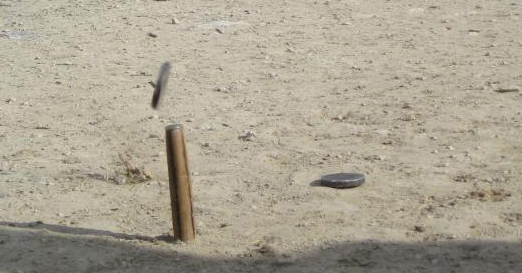EL CALICHE

In this game 6 players are needed and only two pairs compete in the most common practice. The materials needed to play are round or squared “caliche” stones made of iron. The “caliche” is a short round cane or stick of about 20cm long.
The practice of this traditional sport requires a flat area of 35m long and 6m wide.
Elements: The “Caliche” isa cylindrical piece of wood about 20 cm high and 3 cm in diameter that is placed vertically and where players put the number of coins they consider appropriate. These coins are circular pieces of 2 cm in diameter and 2 cm thick. The “moneos” are round or squared sheet metal.
Duration of the game: The game can end after every round played or the teams can set a certain number of rounds to win.
Rules: First, each team member launches a moneo from a specific point of the field to the starting line and the one who gets closer is the first to start. Players take turns throwing moneos to bring down the caliche. A round is considered valid when a player manages to make the caliche fall with his moneo, leaving the coin closer to the moneo than to the caliche. When a player shoots down the caliche and the coin is farther from the moneo than it is from the caliche the move is known as "ganga”. To consider this move valid, the following players must throw his moneo closer to the coin than the caliche –move called “arrime”- or try to hit the caliche to drag and move the coin closer to his moneo –move called “arrastre”. The round is void when none of the players brings down the caliche.
Players: Each team consists of two or three players.
Game development: a cane or stick about 20 cm high is placed vertically on the ground and coins of all participants are also placed on the ground or on the caliche, and then two pieces of caliche are used to attempt making them fall down.
For a shot to be considered valid, the coin should be thrown closer to the projectile launched than to the caliche. Otherwise, ie, when the projectile launched is closer to the fallen caliche than it is to the coin, the play is called “ganga”.
For a “ganga” (bargain) to be valid, the players that have not thrown yet have two options: either to throw another projectile with the purpose of pushing the coin closer to the fallen caliche or to launch the projectile against the caliche so that it gets further away from the coin than from the first projectile.
When the player practices one of these two shots, they are said to play using “arrimar” or “arrastrar” moves.
If the players fail after these two moves, the caliche and the coin are put back into the starting position for a last attempt.
The team throwing first can try again up to four times to bring down the caliche and achieve “ganga”. If successful, the team throwing next must try to make the move valid in order to win.
|
There are other ways of playing caliche that can be considered games of the same family, such as:
- “toka” or “tuka,” which comes from the Basque Country and Navarra.
- “tuta,” practised in Castilla y León.
- “tarusa,” practised in Andalusia and Extremadura.
- “chito,” practised in Madrid and Guadalajara.
All of them are very similar, almost identical.
|

